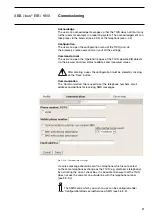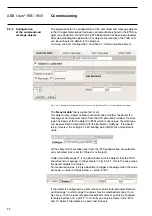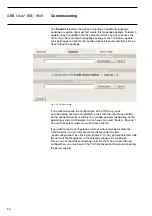
22
ABB i-bus
®
EIB / KNX
The prerequisite for the configuration of the command and message objects
is that the parameterisation has been carried out beforehand in the ETS pro-
gram (see Chapter 5.2) and that the ETS application has been downloaded.
After downloading the application, the objects are created in the TG/S and
can be configured in detail via the browser.
To do so, click on ‘Configuration’ and then on ‘Communication objects’.
Fig. 5.3.2.1: Example of the general data of the object ‘Light Ground Floor’ (command and message)
The
‘General data’
tab is visible first of all.
The object name, object number and information whether the object is a
message or command are taken from the ETS parameter window. If a data
type has been set for the object (in ETS) which is not unique, the data type
can be specified in more detail with the parameter ‘Subtype’. It is possib-
le e.g. to select the subtype ’16 bit floating point (EIS5)’ for a temperature
value.
All the objects that are taken over from the ETS configuration are automati-
cally activated (tick is set for ‘Object is activated’).
Under „Send Message if”, it can be defined in which object state the TG/S
should send a message. In the example in Fig. 5.3.2.1, this is the case when
the object adopts the value 0.
For measured values, it is also possible to trigger a message when the value
exceeds (>=value) or drops below (<=value) a limit.
If the object is configured as a command, it can be entered under ‘Remote
control range’ in which range the values may be modified remotely. It can
be set e.g. that the room temperature setpoint value may only be changed
remotely between 16° and 23 °C. An entry can only be made in the ‘from’
and ‘to’ fields if the object is a command (tick set).
5.3.2
Configuration
of the command and
message objects
Commissioning






























